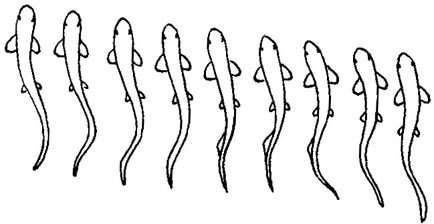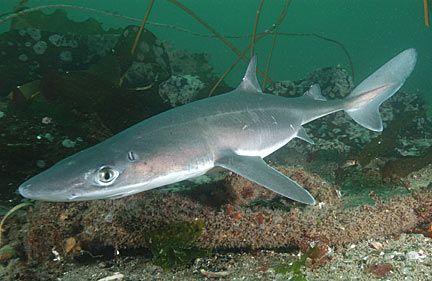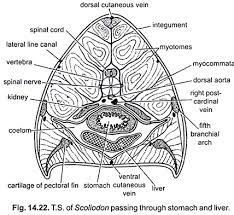Myotomes:
The locomotion of Scoliodon is controlled by the lateral body muscle majorly. Most of the body muscles are arranged laterally and show segmentation. Muscular segments of their lateral side are present just below the skin, the muscle segments are arranged in a zigzag fashion, each segment of the lateral body muscle is known as myotomes.
The myotomes are separated from each other by a tough connective tissue known as myocommas. The myotomes look like concentric rings in the transverse section but superficially they look like hollow cones.

The tough connective tissue septa between each myotome are connected to the skin externally and internally they are connected to the vertebral column. In between two myocommas each myotome have a bundle of parallel striated muscle fibers.
When the parallel striated muscle between two myocommas contracts, two myocommas come close. Each myotome is connected to the vertebral column and skin, so when the myocommas come close to each other, the vertebral column, as well as the body, bend laterally.
The muscle fibers are much thicker in the trunk region as compared to the muscle present in the head and tail. Especially the dorsal side of the body has thick muscle fibers as compared to the ventral side of the body.
The muscles present in the head region do not show segmentation or myotomes, the Segmentation of muscle is only observed in the trunk as the tail region. The muscles present in the head region are for the movement of the pharynx, movement of eye and jaw movement.
Locomotion of Scoliodon:
The swiftness in swimming of Scoliodon is due to a special type of muscle contraction of each myotome. The muscle fibers contract in a special manner in the myotomes, the contraction pass from the anterior part of the body to the backward direction, the myotomes of the right and left side contract alternatively.
This type of muscle contraction in which the right side and the left side myotomes contract alternatively create a wave-like flow of contraction from anterior part to posterior part and this type of muscle contraction is known as metachronal contraction.
The muscle fibers of myotomes are very active and Scoliodon can produce more than 50 metachronal contraction waves per minute. How Scoliodon can produce such a wave in a short time span it is not yet clear.

The rhythmical contraction of myotomes is controlled by the spinal cord, the rhythmic muscle contraction of the myotomes causes alternate bending of the body laterally. When the body bends laterally alternatively on right and left sides it creates an undulating movement in the trunk and tail, this undulation is responsible for the swimming movement of the Scoliodon.
The impulse applied by the tail and trunk in water creates a propulsive force in water which helps them to swim and the streamlined body reduces the water resistance during swimming. During their swimming, the movement of the large strong heterocercal tail helps them to navigate in water.
The hypochordal lobe of the caudal fin is more flexible than the epichordal lobe of the caudal fin which helps in the uplifting of the caudal fin. The large pectoral fins are supported by strong gill rays, the pectoral fins help in maintaining a level in a certain vertical plane in the water.
The dorsal fin help to become stable in a horizontal plane, the dorsal fin prevents whirling movement of the body and gives them stabilization. The pelvic fin has no special role in locomotion but in some cases, they take part in reproduction. In male Scoliodon the ventral fin has some structure known as clasper which takes part in copulation.

So if we summarize the complete movement of Scoliodon then we have to say that, the myotomes are responsible for the undulation movement in the water. The lateral undulation movement causes the propulsive force for swimming, the pectoral muscle help in taking a turn and stabilizes their body in a vertical plane. The pelvic fin has no role in locomotion but it has a great role in the movement, the median fin prevents rotation in the water.
Detailed Study On
Placoid Scales In Scoliodon (Exoskeleton)
Skin of Scoliodon (Integument)
External Morphology of Scoliodon
Scoliodon: Habits Habitat and Geographical Distribution
Hi Everyone!!! Welcome to Imaluop. Imaluop always try to learn some new and he want to share to other people. Here we will try to learn various topics on Science, specially on Biological Sciences.